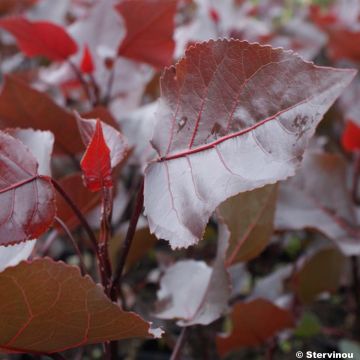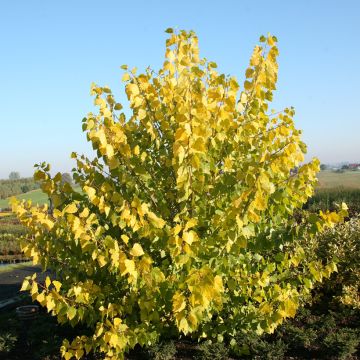

Populus nigra Lombardy Gold - Black Poplar


Populus nigra Lombardy Gold - Black Poplar
Populus nigra Lombardy Gold - Black Poplar
Populus nigra Lombardy Gold
Black Poplar, Lombardy Poplar
This item cannot be shipped to the selected country
Oversize package delivery charge from €6.90
More information
Oversize package delivery charge from €6.90
More information
Schedule delivery date,
and select date in basket
This plant carries a 24 months recovery warranty
More information
We guarantee the quality of our plants for a full growing cycle, and will replace at our expense any plant that fails to recover under normal climatic and planting conditions.
Oversize package: home delivery by special carrier from €6.90 per order..
Express home delivery from €8.90.
Does this plant fit my garden?
Set up your Plantfit profile →
Description
Populus nigra 'Lombardy Gold' is a Black Poplar that should not be confused with the Italian Poplar. It is a compact columnar variety with golden foliage. It blooms between February and March. Beautiful as a windbreak, it is perfect for moist soils. It has a slower growth rate than the species.
Populus nigra belongs to the Salicaceae family. It is native to central and southern Europe, temperate Asia, and northern Africa. Depending on the region, it is also known as Liard, Liardier, Swiss Poplar, French Poplar and Common Poplar. Thriving in moist to wet soils, this poplar develops an extensive and spreading root system, and it tends to sucker. For this reason, it should be planted away from buildings (at least 30 m).
Black Poplar can reach a height of 30 m and a width of 9 m, and it has a fast growth rate. This tree, highly resistant to cold, can live up to 400 years. Black Poplar has an upright trunk that reaches the top of the crown, with large secondary branches and multiple fine branches that may be more or less erect. It is branched quite low on the trunk. The overall shape is irregular, and on mature specimens, the dark brown to blackish bark becomes rough, with a characteristic diamond pattern. Sometimes, the trunk may have large gnarls. The young bark is smooth, thin, and greyish. Small buds appear on the branches in early spring. Black Poplar is a dioecious plant, meaning there are male and female individuals. It flowers in March-April. The inflorescences are pendant catkins: the male catkins, without peduncles, are reddish-purple, and the female catkins, hanging on peduncles, are greenish-yellow. After wind pollination, the female trees bear fruits in clusters, and the cottony seeds are dispersed by the wind.
The 'Lombardy Gold' Black Poplar is characterised by its upright and narrow habit and its small size. Its foliage, which is dark green in the species, is golden here. It reaches a height of 4 m after 10 years of cultivation. At maturity, it reaches a maximum height of 6 m and a width of 2.5 m.
Populus nigra 'Lombardy Gold' prefers moist and humus-bearing soil. Like other poplars, it is perfect, for example, along rivers or near ponds and large natural pools. It can be associated with Common Alder, Willow, and Ash, which also appreciate proximity to water. When planted closely together, this tree can also serve as a small windbreak.
Plant habit
Flowering
Foliage
Botanical data
Populus
nigra
Lombardy Gold
Salicaceae
Black Poplar, Lombardy Poplar
Cultivar or hybrid
Other Populus - Poplar
Planting and care
Plant Populus nigra 'Lombardy Gold' in well-worked, rich soil that remains moist to damp. It requires a sunny exposure. This tree prefers riverbanks and alluvial valleys. However, it can tolerate normal soils in a wet climate. If necessary, perform maintenance pruning before the start of the growing season, removing diseased or dead wood and crossed branches. This tree may be susceptible to certain diseases (galls) without great severity. Poplar canker, caused by a pathogenic fungus, can be more virulent, especially in plants weakened by poor growing conditions (too dry or poor soil). Poplar is the host of an elegant night butterfly called the Poplar Hawk-moth (Laothoe populi).
Planting period
Intended location
Care
This item has not been reviewed yet - be the first to leave a review about it.
Haven't found what you were looking for?
Hardiness is the lowest winter temperature a plant can endure without suffering serious damage or even dying. However, hardiness is affected by location (a sheltered area, such as a patio), protection (winter cover) and soil type (hardiness is improved by well-drained soil).

Photo Sharing Terms & Conditions
In order to encourage gardeners to interact and share their experiences, Promesse de fleurs offers various media enabling content to be uploaded onto its Site - in particular via the ‘Photo sharing’ module.
The User agrees to refrain from:
- Posting any content that is illegal, prejudicial, insulting, racist, inciteful to hatred, revisionist, contrary to public decency, that infringes on privacy or on the privacy rights of third parties, in particular the publicity rights of persons and goods, intellectual property rights, or the right to privacy.
- Submitting content on behalf of a third party;
- Impersonate the identity of a third party and/or publish any personal information about a third party;
In general, the User undertakes to refrain from any unethical behaviour.
All Content (in particular text, comments, files, images, photos, videos, creative works, etc.), which may be subject to property or intellectual property rights, image or other private rights, shall remain the property of the User, subject to the limited rights granted by the terms of the licence granted by Promesse de fleurs as stated below. Users are at liberty to publish or not to publish such Content on the Site, notably via the ‘Photo Sharing’ facility, and accept that this Content shall be made public and freely accessible, notably on the Internet.
Users further acknowledge, undertake to have ,and guarantee that they hold all necessary rights and permissions to publish such material on the Site, in particular with regard to the legislation in force pertaining to any privacy, property, intellectual property, image, or contractual rights, or rights of any other nature. By publishing such Content on the Site, Users acknowledge accepting full liability as publishers of the Content within the meaning of the law, and grant Promesse de fleurs, free of charge, an inclusive, worldwide licence for the said Content for the entire duration of its publication, including all reproduction, representation, up/downloading, displaying, performing, transmission, and storage rights.
Users also grant permission for their name to be linked to the Content and accept that this link may not always be made available.
By engaging in posting material, Users consent to their Content becoming automatically accessible on the Internet, in particular on other sites and/or blogs and/or web pages of the Promesse de fleurs site, including in particular social pages and the Promesse de fleurs catalogue.
Users may secure the removal of entrusted content free of charge by issuing a simple request via our contact form.






































